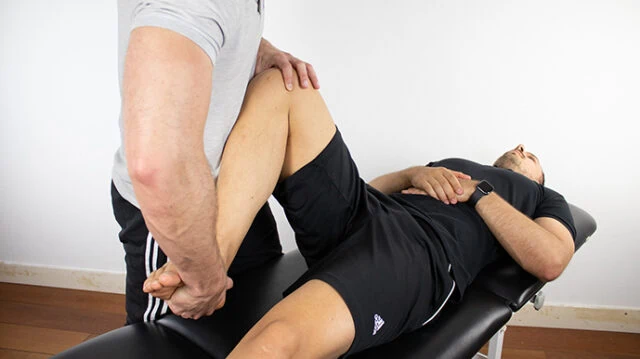McMurrays test (Kne)
- Fysiobasen

- Oct 2
- 3 min read
Meniscal injuries are the most common knee injuries, with the medial meniscus affected more often than the lateral in a ratio of approximately 2:1 [1][2]. Acute meniscal tears typically occur in sports-related incidents, especially during rotational movements in a partially flexed, weight-bearing knee [3]. In older individuals, meniscal ruptures are often associated with degenerative changes.
The McMurray Test is widely used to detect meniscal injury, particularly tears involving the medial or lateral meniscus.
Test Procedure
Patient Position
The patient lies supine with the knee maximally flexed.
Therapist Position
Stands on the side of the knee being tested.
Proximal hand: Stabilizes the knee and palpates the joint line (thumb on one side, fingers on the other).
Distal hand: Holds the sole of the foot, supporting the limb and guiding movements.
Test Execution
Start position: Knee maximally flexed.
Lateral meniscus assessment:
Internal rotation (IR) of tibia + varus stress.
Knee is gradually extended while maintaining IR and varus stress.
This stresses the posterior horn and mid-portion of the lateral meniscus.
Medial meniscus assessment:
External rotation (ER) of tibia + valgus stress.
Knee is gradually extended while maintaining ER and valgus stress.
This stresses the posterior horn and mid-portion of the medial meniscus.
Note: The test primarily loads the posterior and middle portions of the meniscus. The anterior portion is less effectively assessed due to reduced load in this position.
Interpretation of Findings
Positive Test
Pain: Localized medial or lateral knee pain, often aggravated by bending, squatting, or twisting.
Snapping sensation: Feeling of something slipping or shifting inside the joint, often due to a displaced meniscal flap.
Audible click: Clicking or popping sound during movement, suggesting a meniscal fragment being caught.
Locking: Inability to fully flex or extend the knee, typical in “bucket-handle” tears where the meniscus becomes trapped between articular surfaces.
IR + varus stress → lateral meniscusER + valgus stress → medial meniscus
Evidence
Sensitivity: 70%
Specificity: 71% [9]
Meta-analyses show wide variability, partly due to methodological weaknesses in studies [8].
The McMurray Test has limited diagnostic value alone but improves when combined with Apley’s Test and joint line palpation.
The Reider’s modification is reported to have the highest diagnostic accuracy [10].
Conclusion
The McMurray Test remains a useful but imperfect clinical tool for diagnosing meniscal tears. Due to moderate sensitivity and specificity, it should not be used in isolation. A positive test with pain, clicking, or locking provides strong clinical suspicion of meniscal injury, but confirmation with imaging such as MRI is recommended when uncertainty remains.
Sources:
Baker PE, Peckham AC, Pupparo F, Sanborn JC. Review of meniscal injury and associated sports. Am J Sports Med. 1985;13(1):1–4.
Campbell SE, Sanders TG, Morrison WB. MR imaging of meniscal cysts: incidence, location, and clinical significance. Am J Roentgenol. 2001;177(2):409–413.
Douglas I, McDermott Meniscal tears. Current Orthopaedics. 2006;20:85–94.
Magee, D.J Chapter 12: Knee, in Orthopedic Physical Assessment. Pg 791. Saunders Elsevier. Canada. 2008.
Piantanida, A.N. Yedlinsky, N.T. Physical examination of the knee, in The Sports Medicine Resource Manual, Editors: Seidenberg, P.H & Beutler, A..I. 2008 Saunders.
Waldman,S.D. Painful conditions of the knee, in Pain Management Vol 1., 2007. Saunders.
Youtu.Be. Retrieved January 9, 2025, from https://youtu.be/UeWDBV2J0DM?si=NNC8qZX81s-9Jtc6
Meserve BB, Cleland JA, Boucher TR. (2008) A meta-analysis examining clinical test utilities for assessing meniscal injury. Clinical Rehabilitation, 22(2), 143-61.
Hegedus EJ, Cook C, Hasselblad V, Goode A, McCrory DC. (2007)Physical examination tests for assessing a torn meniscus in the knee: a systematic review with meta-analysis. Journal of Orthopaedic and Sports Physical Therapy, 37(9), 541-50
H Nalwad; M Agarwal; B N Muddu; M Smith; and Mr. J K Borill (2006). McMurrays test revisited: Evaluation of various methods of performing McMurrays test, Journal of Bone and Joint Surgery - British Volume, Vol 90-B, Issue SUPP_II, 320.










